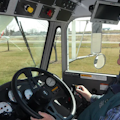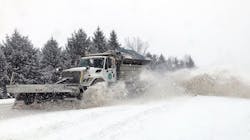Five snow plow spec'ing tips from Ohio DOT
More info on snow operations
On any given day in the late fall and winter (and well into the spring) northern states with cold climates must be ready to remove snow at a moment's notice. And to do that, the snow plows have to be spec'ed with appropriate snow-moving and -melting gear to clear pavement highways and other roads.
For its fleet of 1,525-unit fleet of Class 8 dump trucks, the Ohio Department of Transportation has performance-based specifications it includes in its requests for bids based on years rough winter experience, according to Doug Burke, a transportation engineer who oversees the process.
Here are five aspects to take into consideration when spec'ing the perfect plow.
Powertrain
For power, later-model trucks use Cummins’ 8.9-liter L9 diesel rated at 365 horsepower and torque at 1,150 lb.-ft. That allows use of Allison 3000 RDS (rugged duty series) automatic transmissions. Burke noted that “drivers always want more power,” but higher-output engines would require going to a 4000-series Allison that costs $15,000 to $20,000 more. Like most government agencies, ODOT went to automatics years ago for durability and ease of operation.
Frame
Single-rail frames with the strongest available stiffness are spec’d to avoid problems with “rust jacking”—corrosion buildup that pushes double-channel frame rails apart. Axles brands are whatever the truck builders use as standard. Axles capacities are 20,000 pounds on steer axles and either 26,000-pound single rear drive axles or 46,000-pound tandems.
Suspension
Steel-spring suspensions are used all around: a truck builder’s on steer axles, and Hendrickson RT and RT-463 products for single and tandem rears on Internationals; Freightliners use Tuftrac or something similar over rear axles. Differentials have driver-controlled locking mechanisms, useful in slippery conditions such as when starting out; electronic traction control otherwise suffices while underway.
About three-quarters of the fleet are tandems because of their higher carrying capacity of salt and salt brine. They’re also more stable while pushing snow and steer better, he said. More nimble single-rear-axle trucks are retained for hilly areas where roads are curvier.
Dump bed
Dump beds are fashioned of stainless steel, now common among municipal truck operators because it resists salt-caused corrosion that attacked old mild-steel beds. ODOT has found that although stainless steel beds cost more than twice as much as mild steel, the stainless bodies can be reused two or three times on fresh chassis.
Dump beds on single-axle trucks have hopper bottoms that move salt to spreaders, and the tandems’ longer bodies have trough bottoms with augers.
Wheels
ODOT went to aluminum wheels about four years ago. They don’t save a lot of weight on ODOT’s straight trucks compared to formerly used steel wheels, but they are more resistant to cracking. Some come through with polished surfaces, but Burke said they’re not spec’d that way. “Nonferrous” fuel tanks and hangers are also good at resisting corrosion.
Check out the full article on our affiliate site Construction Equipment for more detailed guidelines on snow plow spec'ing.
About the Author

Tom Berg
Tom Berg is widely acknowledged as one of the top truck writers in the industry. He has covered construction for more than 34 years and has test-driven well over 150 trucks for Construction Equipment.
